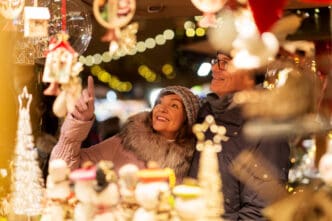Your Essential Overview
The Destination’s Lore
Making the Trip Yours
Perspectives from the Road
Embarking on a journey to Europe’s enchanting Christmas markets offers an unparalleled holiday experience, drawing millions of travelers annually from late November through Christmas Eve. These festive gatherings, predominantly found across Germany, Austria, France, and Central Europe, transform historic city centers into dazzling winter wonderlands. They provide a unique opportunity for visitors to immerse themselves in centuries-old traditions, discover artisanal gifts, savor seasonal culinary delights, and soak in an atmosphere of unparalleled holiday cheer.
Understanding the Magic of European Christmas Markets
The tradition of Christmas markets, or Christkindlmarkt in German, dates back to the late Middle Ages in German-speaking Europe. These markets originated as a way for townspeople to stock up on winter supplies and enjoy communal festivities before the advent season. Today, they are vibrant cultural spectacles, characterized by wooden stalls, twinkling lights, the scent of mulled wine and gingerbread, and the sound of carols.
What makes these markets truly magical is their ability to transport visitors to a bygone era. Each market, whether sprawling in a grand city square or nestled in a quaint village, offers a distinct local flavor. They are not merely shopping venues but living traditions, celebrating craftsmanship, community, and the spirit of the season.
Top Destinations for Unforgettable Christmas Market Experiences
While nearly every European city hosts some form of Christmas market, certain destinations are renowned for their scale, history, and unique charm. Planning your itinerary around these iconic locations ensures a truly memorable holiday adventure.
Germany: The Birthplace of Christmas Markets
Germany is arguably the undisputed home of Christmas markets, boasting some of the oldest and most celebrated. Nuremberg’s Christkindlesmarkt is perhaps the most famous, known for its traditional wooden stalls, Nuremberg sausages, and Lebkuchen (gingerbread). Dresden’s Striezelmarkt, dating back to 1434, is Germany’s oldest, celebrated for its unique wooden crafts and the famous Dresden Stollen cake. Cologne offers a multitude of markets, with the largest set against the stunning backdrop of its magnificent cathedral.
Austria: Alpine Charm and Imperial Grandeur
Austria’s markets blend imperial elegance with alpine warmth. Vienna hosts several stunning markets, most notably the Rathausplatz Christmas Market in front of the City Hall, which transforms into a sparkling fairy tale landscape. Salzburg, Mozart’s birthplace, offers a romantic market at the foot of its fortress, known for its traditional handicrafts and choral singing.
France: Alsatian Fairytale Markets
In the Alsace region, particularly Strasbourg and Colmar, French markets blend German traditions with French flair. Strasbourg, the “Capital of Christmas,” boasts one of Europe’s oldest and largest markets, spreading across multiple squares with its distinctive Alsatian timber-framed houses. Colmar’s market is a picturesque affair, winding through its charming canal-lined streets, often described as a living storybook.
Czech Republic: Prague’s Medieval Splendor
Prague’s Christmas markets are set against the stunning backdrop of its Gothic architecture, particularly in the Old Town Square and Wenceslas Square. These markets are known for their festive atmosphere, traditional Czech food like Trdelník (a sweet pastry), and unique handcrafted gifts. The evening lights illuminate the historic cityscape, creating an enchanting experience.
Hungary: Budapest’s Festive Heartbeat
Budapest offers two main Christmas markets: one at Vörösmarty Square and another in front of St. Stephen’s Basilica. Both are celebrated for their artisanal crafts, traditional Hungarian delicacies, and lively cultural programs, including folk dances and concerts. The Basilica market features a stunning 3D light show projected onto the facade of the basilica.
What to Expect and Enjoy at the Markets
Beyond the picturesque scenery, Christmas markets are a feast for the senses, offering unique culinary experiences and unparalleled shopping opportunities.
Culinary Delights
Food and drink are central to the market experience. You’ll find an abundance of Glühwein (mulled wine) in Germany and Austria, or Vin Chaud in France, often served in collectible mugs. Other popular treats include roasted chestnuts, sweet and savory crepes, sizzling sausages (Bratwurst), gingerbread (Lebkuchen), potato pancakes (Reibekuchen), and regional specialties unique to each market.
Unique Shopping and Crafts
The markets are a treasure trove for unique gifts and souvenirs. Expect to find intricately carved wooden toys, delicate glass ornaments, handmade candles, ceramic goods, traditional textiles, and artisanal jewelry. Many vendors are local craftspeople, offering items that reflect regional heritage and skill, making for truly authentic purchases.
Festive Atmosphere and Entertainment
The air is thick with the scent of pine and spices, often accompanied by the sound of carol singers, brass bands, or live festive music. Many markets feature ice skating rinks, Ferris wheels, nativity scenes, and even visits from Santa Claus, making them ideal for families. The sheer volume of twinkling lights and decorations creates an undeniably magical ambiance.
Planning Your Christmas Market Trip
To maximize your enjoyment and minimize stress, a little strategic planning goes a long way.
Best Time to Visit
Most markets open in late November and run until December 24th or 26th. Visiting during the week, especially in the mornings or early afternoons, will help you avoid the largest crowds. Early December often provides a sweet spot between festive atmosphere and manageable visitor numbers. Consider arriving for the opening ceremonies in late November for an extra special experience.
Accommodation and Transportation
Book your accommodation well in advance, as hotels in popular market cities fill up quickly and prices can rise. European train networks are excellent for hopping between cities and markets, offering scenic journeys. Within cities, public transportation is usually efficient, but many markets are centrally located and best explored on foot.
Budgeting and Packing Essentials
While market entry is typically free, budget for food, drinks, and souvenirs. Cash is often preferred by smaller vendors. Pack warm layers, including a waterproof outer shell, gloves, a hat, and a scarf, as you’ll be spending a lot of time outdoors. Comfortable, waterproof walking shoes are an absolute must, and a portable power bank for your phone will keep you connected and snapping photos all day.
Tips for a Memorable Experience
To truly embrace the spirit of the markets, consider these practical tips. Arrive early in the day or visit during off-peak hours to enjoy a more relaxed atmosphere and easier navigation through the stalls. Don’t be afraid to try local delicacies, even if they seem unusual; they are part of the cultural experience. Engage with the vendors, many of whom are passionate about their crafts and traditions. Finally, take your time, soak in the sights, sounds, and smells, and allow yourself to be fully immersed in the holiday cheer.
European Christmas markets offer a truly unforgettable holiday journey, blending ancient traditions with modern festive joy. Whether you’re seeking unique gifts, culinary adventures, or simply a dose of seasonal magic, these enchanting destinations provide a perfect backdrop for creating cherished memories. Start planning your festive escape today and discover the heartwarming charm that awaits.








